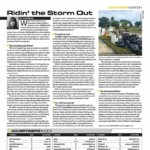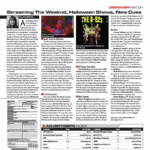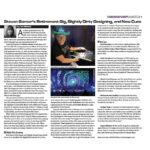Some LDs seek out assignments during the cold-weather off season for outdoor concert touring. Michael Keller, LD for Ozzy Osbourne and other touring artists, has worked with the auto shows on and off for more than 20 years with titles ranging from designer to master electrician. This year, Keller was involved with NAIAS in Detroit, LAAS in Los Angeles, the Philadelphia Auto Show, the St. Louis Auto Show, and CIAS in Chicago.
Others, like LD Jim Tetlow of Nautilus Entertainment Design, make it their business to focus on this big corporate niche. Tetlow has been lighting auto shows since 1981 and recently completed assignments for General Motors at the big auto shows in Chicago and New York.
 PLSN spoke with both Keller and Tetlow about these unique shows, where the car’s the star.
PLSN spoke with both Keller and Tetlow about these unique shows, where the car’s the star.
» PLSN: What are some of the unusual challenges of auto shows?
 Jim Tetlow: We recently had a very small “by invitation only” event for selected members of the automotive press to view the new Chevy Impala in San Diego, where we lifted a car by crane from the street above and over a condo building to place it on a sixth floor open terrace belonging to the penthouse. The guests arrived via elevator with no idea that the car was on the terrace. It was a very tight fit!
Jim Tetlow: We recently had a very small “by invitation only” event for selected members of the automotive press to view the new Chevy Impala in San Diego, where we lifted a car by crane from the street above and over a condo building to place it on a sixth floor open terrace belonging to the penthouse. The guests arrived via elevator with no idea that the car was on the terrace. It was a very tight fit!
Michael Keller: There was one time the client had a press event where a one-of-a-kind car prototype showed up — it was painted dark purple, and the client wanted it to look black. They asked us if we could light the car to make it photograph black. For another event in New York City, the power transformer blew and took out 60 fixtures. Then there was a burst water main in Chicago in the dead of winter. Need I go on?
» PLSN: How have the budgets and equipment changed over the years?
Michael Keller: In the early years, most of the time the show was only lit with house lights. Then came the installation of hanging PAR 64 fixtures from the house beams. It was a major step, but slow and costly. To speed up the installation, companies started using truss and motors. The use of moving lights started in for convenience and daylight color temperature. Daylight MSR 575 PARs became the fixture of choice for most display lighting.
With all these changes, the budgets had to adjust accordingly. Some exhibitors select certain shows where their budget is larger or smaller. Some foreign auto makers will import fixtures from all over the world for the major shows — and that is very expensive. It all depends on the market where the show is. In the past few years, LEDs have become a major light source in the auto show circuit. While the first ones out were sub par, the current ones are nearly the output of a MSR 575.
Jim Tetlow: We have seen budget reductions in a number of auto show projects, but it’s not just the auto shows that are reducing their budgets. In almost every sector in which we work we are seeing clients asking us to do more for less money. It just becomes yet another challenge in doing the job successfully.
» PLSN: Describe the scope of what you design.
Michael Keller: Each auto show is different. In certain major cities, the show will have a launch or a press event for each auto maker. Sometimes these take place within the booth space, while other times it will be in a remote location. While there is no set formula, the press events will have more theatrical lighting while the booths tend to focus on display lighting. Again, these are all budget driven.
Jim Tetlow: We are involved in numerous aspects of lighting for the auto industry. For example, we are currently lighting all of the GM exhibits at the major consumer auto shows, including Los Angeles, Detroit, Chicago and New York. We are also lighting the press events at these consumer shows and an additional offsite Cadillac event at Jazz at Lincoln Center. We also work on press events separate from the consumer shows. Separately, we also light the dealer launches for a variety of manufacturers. Currently we are working on shows for Cadillac, Toyota, Jaguar and Land Rover.
» PLSN: Are there any differences in designing for the different cities?
Michael Keller: Chicago’s McCormick Place has the largest footprint, and they use in-house overhead lights. [Extra booth lighting is optional.] Detroit has an amazing amount of space to hang gear. [Cobo Center, home of NAIAS] was originally designed to have an eight-story hotel above it. That didn’t happen, so you can hang anything in there — the weight capacity is incredible.
Detroit is probably the main show, and more foreign vendors exhibit there. Plus, you can move in earlier — we started building in November for the show in January. You have to get the lights in before the sets come in. People build entire buildings in there with drywall. The Germans bring lots of steel work and their own high output lighting.
The Los Angeles show is building up and is probably becoming the second strongest show for foreign vendors.
» PLSN: Is there a universal design formula you have created that works best when lighting cars?
Michael Keller: Once a floor plan is issued, you need to find out what the client would like to see, and, again, the budget. Some shows want only platform or turntable cars lit, some want them all lit. They actually want everything lit, but the budget dictates the actual outcome. A simple formula for floor vehicles is four to six lighting fixtures per vehicle, while turntables go between six to 10 fixtures. Did I mention budget?
Jim Tetlow: It depends on a variety of factors. The large consumer exhibits require 360-degree lighting for upwards of 80 or 90 vehicles in a large convention center, where the public can walk anywhere. We need to surround the cars with lights so that they look good from every angle. The press events and dealer launches are much more presentational, with a defined point of view of the vehicle. We can be more selective in terms of lighting positions and angles. Frequently, the vehicle designers will want to be involved in the process, as they have concerns related to highlighting sculptural lines of the car and making sure that specific colors and paint treatments appear correct.
One thing you learn rapidly in lighting cars is that there are a lot of specular surfaces, including chrome, glass and mirrors. When you combine that with the turntables that are used for most exhibits and shows, you realize that reflections appear different from every seat in the audience. You simply don’t have the control that you would have in a studio environment where you can light the car using lighting reflective surfaces such as a cyc or bounce cards. In any case, the goal is simply to make the product look as elegant and sexy as you can. Cars are more than mere transportation — they are aspirational products, meaning that, in many cases, people project themselves, or how they would like to be seen, through their choice of vehicle. Lighting, if done right, plays a large part in selling the product to the customers.
» Quick Cues…
LD Leroy Bennett has been involved with a number of 2013 concert tours, for Beyonce, Paul McCartney, Rammstein, How To Destroy Angels (featuring Nine Inch nails frontman Trent Reznor), Nine Inch Nails and Bruno Mars…LD Jeff Ravitz recently designed the lighting for an upcoming PBS special featuring the Italian operatic pop vocal trio, Il Volo. Two shows were taped before a live audience at Miami’s Jackie Gleason Theater. One of the shows will be a summer broadcast, while the other will be a Christmas season release. Ravitz also lit the fourth annual All Star Comedy Jam presented by Shaquille O’Neal. The show will air on Showtime this spring. Earlier this year, Ravitz and his associate, Kristie Roldan, designed the lighting for the annual TED Conference in Long Beach, CA…LD Brett Lorins is preparing for a summer festival season as LD for Bad Religion, who will be out in support of their newest album. He recently provided video direction for Kid Cudi…LD Michael Keller is out with Black Sabbath’s world tour, which just kicked off in New Zealand. “It is being well received,” he says…LD Peter Morse is back with Barbra Streisand’s Back to Brooklyn tour, which started last fall and has now added dates in Europe and for the first time, Israel. The concerts run mid-May through mid-June. Other shows Morse designed are still running, including Carrie Underwood’s tour and Shania Twain’s run at Caesars in Las Vegas…LD Marty Postma designed and directs Alice in Chains’ tour, which started April 25 in Miami. The band makes one of its first cross-country runs across Canada this summer.
Share your news with Debi Moen at dmoen@plsn.com.


